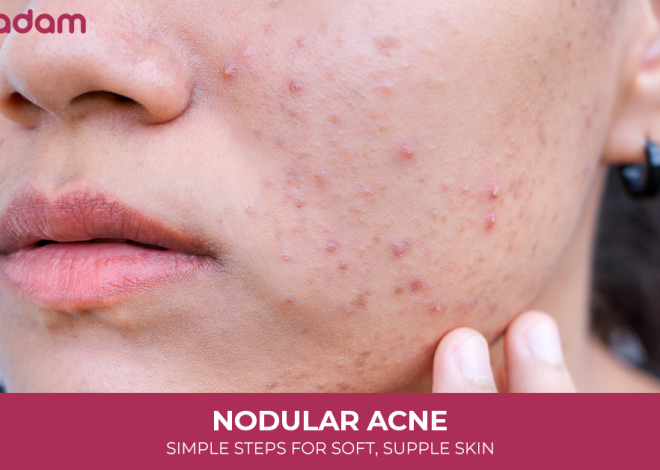
How to Remove Dead Skin From Face: Tips and DIY Care Routine
Dead skin is a vexing issue and occurs because of dirt deposits, damaged skin cells, dry weather, and the daily wear and tear of the skin.
Our skin undergoes a natural cell renewal cycle every 30 days or so. This process is termed cell turnover.
But in this long waiting period of 1 month or so, it is still possible for the dead skin cells to build up on the skin’s surface.
Read this guide further on how to remove dead skin from face , including the causes, natural DIY exfoliation methods, and other additional tips to achieve radiant-looking skin.

Table of Contents
Dead Skin on Face Explained
Dead skin cells are a natural part of the skin regeneration process. However, they can affect the outermost layer of your skin, which is why it’s important to understand how to remove dead skin cells from the face and support your skin’s health.
Dead skin cell accumulation occurs because of factors like poor cleansing, ageing, and environmental stressors. A skincare routine with a strong emphasis on exfoliation, cleansing, hydration, and sun protection is important. Moreover, Diy remedies on how to remove dead skin from face at home also play a crucial role in addressing dead skin cells.
Causes of Dead Skin Cells on Face
Natural shedding of dead skin cells is the normal process. The real problem occurs when these cells accumulate skin’s surface instead of being removed. So, it is important to understand the major causes of dead skin accumulation as highlighted below:
- Ageing: With the increase in age, the shedding process slows down gradually. This causes the buildup of dead skin cells.
- Exposure to the sun: Prolonged UV radiation exposure not only destroys the skin cells, but may even cause an increased deposit of dead skin on face, feet, or hands.
- Inadequate cleansing: Not washing your face regularly will make it unclean and cause the buildup of dead skin cells on your face.
- Adverse climate and weather: Dry or extreme weather conditions might cause loss of hydration. It might potentially clog the dead skin cells and cause a buildup of toxins.
- Other skin issues: Other skin conditions like psoriasis and eczema might also cause dead skin and its accumulation.
How to Remove Dead Skin from Face Naturally at Home
To remove dead skin from face at home, you can use a variety of gentle exfoliating methods.
Here’s a more detailed look at some natural exfoliation methods:
Sugar Scrub: Mix equal parts sugar and olive oil to create a gentle, moisturizing scrub. Massage the scrub onto your face in circular motions, then rinse with warm water and moisturize.
Coffee Scrub: Finely ground coffee provides natural exfoliation and can help with circulation. Mix coffee grounds with a little water, oil, or yogurt to form a paste and gently massage it into your skin.
Oatmeal Scrub: Grind oatmeal into a fine powder and mix it with honey or yogurt to create a gentle, soothing scrub. Oatmeal is great for sensitive skin and can help reduce inflammation.
Dry Brushing: Use a soft-bristled brush to gently exfoliate your face. Dry brushing helps remove dead skin cells and can improve circulation.
Rice Flour Mask: Mix rice flour with yogurt and honey to create a mask that gently exfoliates and brightens the skin.
Banana Scrub: Mash a ripe banana and mix it with a little oatmeal or sugar to create a natural exfoliant that softens and hydrates the skin.
Apple Cider Vinegar: Dilute apple cider vinegar with water and apply it to your face as a gentle exfoliant, but be sure to patch test first.

Important Considerations for how to remove dead cells from the face at home :
Frequency: Exfoliate your face 1-2 times per week to avoid over-exfoliating and causing irritation.
Sensitivity: If you have sensitive skin, choose gentler methods like oatmeal or banana scrubs.
Moisturize: Always moisturize your face after exfoliating to keep it hydrated and prevent dryness.
How to Check Dead Skin Cells Build Up as Per Skin Type?
Here is a detailed outline for how to check for dead skin cell buildup as per different skin types, Common signs, methods to test at home, and recommended exfoliation tips.
| Skin type | Signs of dead skin cell buildup | How to check at home | Recommended exfoliation method |
| Oily skin | Clogged pores, rough texture. | After cleansing, put a blotting paper on the skin; oil with rough patches is a sign of buildup. | Gentle scrubs. |
| Dry skin | Dull/ashy look. | Scratch using a fingernail gently; if there are white flakes, it’s dead skin. | Lactic acid, a gentle wash cloth. |
| Acne-prone skin | Blackheads/ whiteheads, congested pores, textured bumps. | Check for gritty texture, using fingertips after cleansing. | AHA/ BHA combo toner. |
| Sensitive skin | Irritation, redness, or rough patches. | Without much pressure, dab a cotton pad over the skin if dry flakes appear. | Enzyme exfoliants (papaya). |
| Normal Skin | Slightly rough areas. | Check the skin under light -build up indicates a matte or lifeless finish. | Change between physical and chemical exfoliants weekly. |

Additional Tips to Remove Dead Skin from Face
- To remove dead skin from face, choose a product specifically designed to be applied on the face. Do not apply products made to be designed for other body parts, as they may act too harsh on the delicate part of the skin.
- Do not exfoliate if there is an existing skin condition or on damaged or sunburnt skin. So, always first check the exfoliants on a small patch of skin.
- All types of exfoliation increase your skin’s sensitivity to Ultraviolet radiation (UV). So, follow up with a moisturizer after exfoliating and use SPF sunscreen to protect your skin.
- Try to exfoliate before shaving or other methods of hair removal. It does not let the dead skin cells clog pores, which may become more open while you save.
- Do not exfoliate on the morning of an important event, or even the night prior. Since removing dead skin from face may lead to redness or irritation.
Conclusion
Having the best knowledge on how to remove dead skin from face is an important aspect in any skincare routine. Ignoring this aspect might cause deteriorating skin health. Exfoliation is a crucial component of the skincare regimen that should be included in the CTM routine. It encourages the new skin to grow properly and helps improve the overall efficacy of other skincare products.
FAQs
How to get rid of dead skin on face naturally?
Gentle exfoliation using natural ingredients like oatmeal. Baking soda, or sugar, is recommended.
How to remove dead cells from face using a vitamin?
Incorporate vitamin C and vitamin E in your skincare routine to reveal glowing and healthy skin.
How to remove dead skin cells from face using oil?
Jojoba oil and castor oil are beneficial specifically for oily or acne-prone skin to remove impurities and dead skin cells.
Which is the best facial treatment to remove dead cells from face?
It varies according to individual skin types or preferences. Chemical exfoliation, manual exfoliation, and professional treatments such as hydrafacial, dermaplaning, etc, are some examples of the best facial treatments.
Can coconut oil help remove dead skin?
Yes, coconut oil is effective in removing dead skin cells if applied as part of the exfoliating routine.
What vitamin deficiency causes dead skin?
Lack of vitamin E causes dead skin. The vitamin concerned helps maintain healthy skin by supporting the cell turnover function.
Is vitamin C effective for removing dead skin?
Yes, vitamin C can help eliminate dead skin cells, even though it is not primarily known as an exfoliant.
How do I remove dead skin from my legs?
Exfoliation helps get rid of dead skin from the legs. Exfoliate using a scrub or exfoliating tool to eliminate the outer surface of dead skin cells.
What are the exfoliating tools to remove dead skin?
Exfoliating tools like scrubs, brushes, and mitts help remove dead skin cells effectively.
Which is the best professional treatment to remove dead skin from face?
Dermaplaning, which is a minimally invasive treatment, is considered the best professional treatment to help get rid of dead skin from the face.



